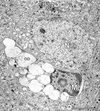Activated microglia in cortex of mouse models of mucopolysaccharidoses I and IIIB
- PMID: 12576554
- PMCID: PMC149931
- DOI: 10.1073/pnas.252784899
Activated microglia in cortex of mouse models of mucopolysaccharidoses I and IIIB
Abstract
Alpha-N-acetylglucosaminidase deficiency (mucopolysaccharidosis IIIB, MPS IIIB) and alpha-l-iduronidase deficiency (MPS I) are heritable lysosomal storage diseases; neurodegeneration is prominent in MPS IIIB and in severe cases of MPS I. We have obtained morphologic and molecular evidence for the involvement of microglia in brain pathology of mouse models of the two diseases. In the cortex, a subset of microglia (sometimes perineuronal) consists of cells that are probably phagocytic; they have large storage vacuoles, react with MOMA-2 (monoclonal antibody against macrophages) and Griffonia simplicifolia isolectin IB(4), and stain intensely for the lysosomal proteins Lamp-1, Lamp-2, and cathepsin D as well as for G(M3) ganglioside. MOMA-2-positive cells appear at 1 and 6 months in MPS IIIB and MPS I mice, respectively, but though their number increases with age, they remain sparse. However, a profusion of cells carrying the macrophage CD68/macrosialin antigen appear in the cortex of both mouse models at 1 month. mRNA encoding CD68/macrosialin also increases at that time, as shown by microarray and Northern blot analyses. Ten other transcripts elevated in both mouse models are associated with macrophage functions, including complement C4, the three subunits of complement C1q, lysozyme M, cathepsins S and Z, cytochrome b558 small subunit, macrophage-specific protein 1, and DAP12. An increase in IFN-gamma and IFN-gamma receptor was observed by immunohistochemistry. These functional increases may represent activation of resident microglia, an influx and activation of blood monocytes, or both. They show an inflammatory component of brain disease in the two MPS, as is known for many neurodegenerative disorders.
Figures



Similar articles
-
Retrovirally transduced bone marrow has a therapeutic effect on brain in the mouse model of mucopolysaccharidosis IIIB.Mol Genet Metab. 2004 Aug;82(4):286-95. doi: 10.1016/j.ymgme.2004.06.004. Mol Genet Metab. 2004. PMID: 15308126
-
Innate and adaptive immune activation in the brain of MPS IIIB mouse model.J Neurosci Res. 2009 Mar;87(4):978-90. doi: 10.1002/jnr.21912. J Neurosci Res. 2009. PMID: 18951493
-
Electrophysiological and Histological Characterization of Rod-Cone Retinal Degeneration and Microglia Activation in a Mouse Model of Mucopolysaccharidosis Type IIIB.Sci Rep. 2015 Nov 26;5:17143. doi: 10.1038/srep17143. Sci Rep. 2015. PMID: 26607664 Free PMC article.
-
The natural history of neurocognition in MPS disorders: A review.Mol Genet Metab. 2021 May;133(1):8-34. doi: 10.1016/j.ymgme.2021.03.002. Epub 2021 Mar 11. Mol Genet Metab. 2021. PMID: 33741271 Review.
-
Molecular genetics of mucopolysaccharidosis type IIIA and IIIB: Diagnostic, clinical, and biological implications.Hum Mutat. 2001 Oct;18(4):264-81. doi: 10.1002/humu.1189. Hum Mutat. 2001. PMID: 11668611 Review.
Cited by
-
Treatment of adult MPSI mouse brains with IDUA-expressing mesenchymal stem cells decreases GAG deposition and improves exploratory behavior.Genet Vaccines Ther. 2012 Apr 20;10(1):2. doi: 10.1186/1479-0556-10-2. Genet Vaccines Ther. 2012. PMID: 22520214 Free PMC article.
-
Ganglioside accumulation in activated glia in the developing brain: comparison between WT and GalNAcT KO mice.J Lipid Res. 2015 Aug;56(8):1434-48. doi: 10.1194/jlr.M056580. Epub 2015 Jun 10. J Lipid Res. 2015. PMID: 26063460 Free PMC article.
-
Impact of intracerebroventricular enzyme replacement therapy in patients with neuronopathic mucopolysaccharidosis type II.Mol Ther Methods Clin Dev. 2021 Feb 27;21:67-75. doi: 10.1016/j.omtm.2021.02.018. eCollection 2021 Jun 11. Mol Ther Methods Clin Dev. 2021. PMID: 33768130 Free PMC article.
-
New therapeutic options for lysosomal storage disorders: enzyme replacement, small molecules and gene therapy.Hum Genet. 2007 Mar;121(1):1-22. doi: 10.1007/s00439-006-0280-4. Epub 2006 Nov 7. Hum Genet. 2007. PMID: 17089160 Review.
-
ZFN-Mediated In Vivo Genome Editing Corrects Murine Hurler Syndrome.Mol Ther. 2019 Jan 2;27(1):178-187. doi: 10.1016/j.ymthe.2018.10.018. Epub 2018 Nov 1. Mol Ther. 2019. PMID: 30528089 Free PMC article.
References
-
- Neufeld E F, Muenzer J. In: The Metabolic and Molecular Bases of Inherited Disease. Scriver C R, Beaudet A L, Sly W S, Valle D, editors. New York: McGraw–Hill; 2001. pp. 3421–3452.
-
- Clarke L A, Russell C S, Pownall S, Warrington C L, Borowski A, Dimmick J E, Toone J, Jirik F R. Hum Mol Genet. 1997;6:503–511. - PubMed
-
- Russell C, Hendson G, Jevon G, Matlock T, Yu J, Aklujkar M, Ng K Y, Clarke L A. Clin Genet. 1998;53:349–361. - PubMed
-
- Li H H, Zhao H Z, Neufeld E F, Cai Y, Gomez-Pinilla F. J Neurosci Res. 2002;69:30–38. - PubMed
Publication types
MeSH terms
Grants and funding
LinkOut - more resources
Full Text Sources
Other Literature Sources
Molecular Biology Databases
Research Materials
Miscellaneous

